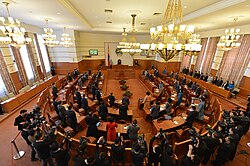| | |
|---|---|
| Mongolian Laws | |
| Constitution of Mongolia Mongolian nationality law Administrative law in Mongolia LGBT rights in Mongolia | |
| Mongolia | |
| Administrative law |
|---|
| General principles |
| Grounds for judicial review |
| Administrative law in common law jurisdictions |
| Administrative law in civil law jurisdictions |
| Related topics |
Administrative law in Mongolia is the body of law that governs the activities of administrative agencies of the Mongolian government. These activities include rulemaking, adjudication, or the enforcement of a specific regulatory agenda.
Contents
- History of administrative law
- Soviet-era
- Post Soviet-era
- Sources of law in Mongolia
- Constitution
- Statutes
- Legal Customs
- International Law
- Areas of administrative rulemaking
- Ministry of Mineral Resources
- Ministry of Environment
- General Customs Office
- Nuclear Energy Agency
- Ministry of Education
- Ministry of Justice and Home Affairs
- National Human Rights Commission
- Process of regulatory rulemaking and discretion of regulators
- Legislature's role
- Executive's role
- Process for private challenges to government actions and rules
- Judicial review of administrative action
- Analysis and assessment of current rules
- Current standard of administrative laws
- State of judicial review
- Comparison with other countries
- See also
- References
- External links








